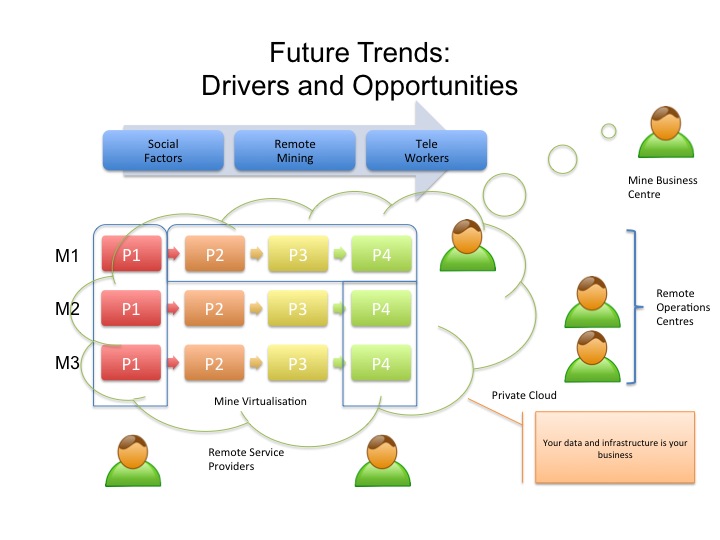Common Mine Model
In June 2012 we submitted the Common Mine Model (CMM) proposal to AMIRA.
The role of the Common Mine Model is to integrate the flow of data across the mine site and the mining process (both horizontally and vertically) back into the mining enterprise. It should be able to support both historical and real-time flow of data. Whatever happens in the mine should be reflected in the CMM, and every action in CMM (initiated by a human operator or artificial intelligence) should be implemented in the real world. Since the CMM spans the entire mining process: from exploration, production, processing to rehabilitation, it is necessary that we seek as many opinions (i.e. requirements and specification) as possible. For example, a CMM that has been designed to support exploration is unlikely to support production. Both have radically different scales in space and time, We need a CMM that supports all processes.
 The CMM is essentially a three-dimensional data model of the ore deposit and surrounds that is updated and maintained over time. Ideally, a geophysically-derived, petrophysical framework is used to support all available petrophysical, geochemical, geological, geotechnical, mining and metallurgical data to build a model of in-situ resources that is improved upon as mining proceeds. By analyzing and modelling the relationships between these inputs, one can estimate in-situ responses, which then can be used to populate the various domains and mining units within the common mine model. Such modelled estimates can be validated or refined using data from blast- holes, or mine faces, before, during or after extraction so that the relationships used for the estimates can be refined, then used to update and improve the model elsewhere. Hence as mining continues there shall be an overall improvement in the reliability of the in-situ data model.
The CMM is essentially a three-dimensional data model of the ore deposit and surrounds that is updated and maintained over time. Ideally, a geophysically-derived, petrophysical framework is used to support all available petrophysical, geochemical, geological, geotechnical, mining and metallurgical data to build a model of in-situ resources that is improved upon as mining proceeds. By analyzing and modelling the relationships between these inputs, one can estimate in-situ responses, which then can be used to populate the various domains and mining units within the common mine model. Such modelled estimates can be validated or refined using data from blast- holes, or mine faces, before, during or after extraction so that the relationships used for the estimates can be refined, then used to update and improve the model elsewhere. Hence as mining continues there shall be an overall improvement in the reliability of the in-situ data model. The Common Mine Model will allow a more complete understanding of the target orebody and its surrounds, by connecting to existing onsite data stores and using all available petrophysical, geochemical, geological, geotechnical, mining and metallurgical data to build a model of in-situ resources that is improved upon as mining proceeds. By analyzing and modelling the relationships between these inputs, one can estimate in-situ responses, which then can be used to populate the various domains and mining units within the common mine model. Such modelled estimates can be validated or refined using data from blast-holes, or mine faces, before, during or after extraction so that the relationships used for the estimates can be refined, then used to update and improve the model elsewhere. Hence as mining continues there shall be an overall improvement in the reliability of the in-situ data model. It is proposed that the future management of mining operations will be conducted in private clouds and there will be a corresponding shift from “Remote Operations Centres” to “Remote Mining Services”.
The Common Mine Model will allow a more complete understanding of the target orebody and its surrounds, by connecting to existing onsite data stores and using all available petrophysical, geochemical, geological, geotechnical, mining and metallurgical data to build a model of in-situ resources that is improved upon as mining proceeds. By analyzing and modelling the relationships between these inputs, one can estimate in-situ responses, which then can be used to populate the various domains and mining units within the common mine model. Such modelled estimates can be validated or refined using data from blast-holes, or mine faces, before, during or after extraction so that the relationships used for the estimates can be refined, then used to update and improve the model elsewhere. Hence as mining continues there shall be an overall improvement in the reliability of the in-situ data model. It is proposed that the future management of mining operations will be conducted in private clouds and there will be a corresponding shift from “Remote Operations Centres” to “Remote Mining Services”. Resources
Resources
- Paper Towards the intelligent future mine: the case for the Common Mine Model
- Presentation Transforming the Future Mine: The case for the Common Mine Model
- Presentation Mining In the Cloud (Prezi) at the Swedish Mining Council (Youtube)
Related Pages
